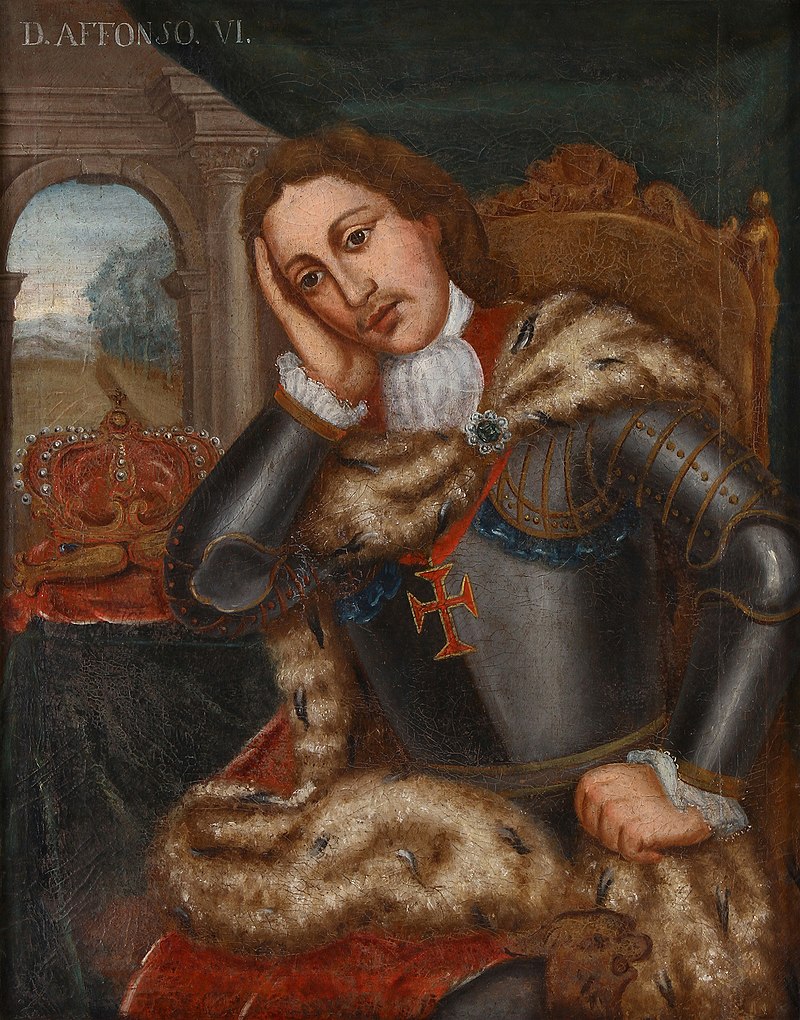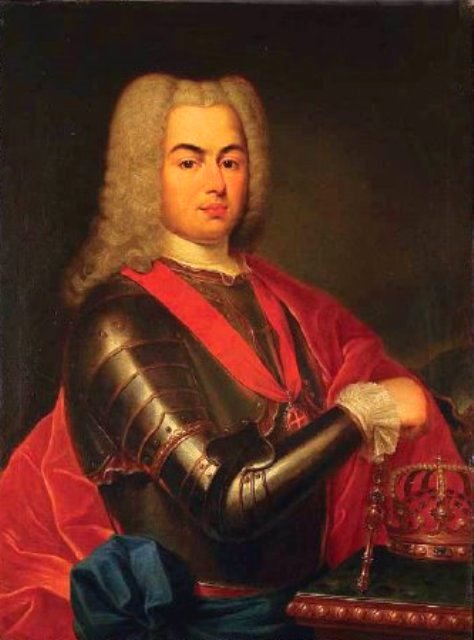by Susan Flantzer
© Unofficial Royalty 2022

Pedro II, King of Portugal; Credit – Wikipedia
Pedro II, King of Portugal was born on April 26, 1648, at Ribeira Palace in Lisbon, Portugal. He was the youngest of the seven children and the fourth but the third surviving of the four sons of João IV, King of Portugal and Luisa de Guzmán y Sandoval. Catherine of Braganza who married Charles II, King of England and King of Scots, was Pedro’s sister. His paternal grandparents were the Portuguese nobleman Teodósio II, 7th Duke of Braganza and the Spanish noblewoman Ana de Velasco y Téllez-Girón. Pedro’s maternal grandparents were the Spanish nobles Juan Manuel Pérez de Guzmán y Silva, 8th Duke of Medina Sidonia and Juana Lorenza Gomez de Sandoval y de la Cerda.
Pedro had six elder siblings:
- Teodósio, Prince of Brazil, Duke of Braganza (1634 – 1653), died at age 19 due to tuberculosis
- Ana of Braganza (born and died 1635), died at birth
- Joana of Braganza, Princess of Beira (1635 – 1653), died in her teens
- Catherine of Braganza, Queen of England, Queen of Scots (1638 – 1705), married Charles II, King of England, King of Scots, no children, had at least three miscarriages
- Manuel of Portugal (born and died 1640), died at birth
- Afonso VI, King of Portugal (1643 – 1683), married Maria Francisca of Savoy, no children
Pedro’s eldest brother Teodósio was the heir to the throne. However, on May 13, 1653, Teodósio died at age 19 due to tuberculosis and Pedro’s brother Afonso became heir to the throne of Portugal. When Afonso was about three years old, he had a “malignant fever” that affected the right side of his body and left him physically and mentally challenged. Today, it is suspected that he had a disease of the central nervous system, perhaps meningoencephalitis. Meningoencephalitis can cause permanent neurological damage including memory difficulty, learning disabilities, brain damage, and gait problems, and Afonso appears to have had those issues. As he was the second son and was mentally challenged, Afonso was not prepared to be king.

Pedro’s brother Afonso VI, King of Portugal; Credit – Wikipedia
When Pedro was eight years old, his father João IV, King of Portugal died on November 6, 1656, and his thirteen-year-old brother succeeded as Alfonso VI, King of Portugal. João IV had appointed his wife Luisa as the regent during the minority of their son Afonso VI. Luisa remained in power until 1662, when Afonso, with the help of his favorite Luís de Vasconcelos e Sousa, 3rd Count of Castelo Melhor, assumed power. Afonso appointed Castelo Melhor his escrivão da puridade (scribe of purity), a position that enabled Castelo Melhor to exercise the functions of a prime minister and control the Kingdom of Portugal. The Portuguese government was split between a pro-French faction led by Luís de Vasconcelos e Sousa, 3rd Count of Castelo Melhor, and a pro-English faction led by Afonso’s brother Pedro. In 1662, Afonso and Pedro’s sister Catherine had married King Charles II of England. Castelo Melhor and King Louis XIV of France saw a French marriage for Afonso as a way to offset his sister’s English marriage.

Maria Francisca of Savoy, Queen of Portugal, wife of both Afonso VI and Pedro II; Credit – Wikipedia
In 1666, Afonso married Marie Françoise of Savoy, daughter of French military leader Charles Amadeus of Savoy, Duke of Nemours, and Élisabeth de Bourbon-Vendôme, a granddaughter of King Henri IV of France and his mistress Gabrielle d’Estrées. Problems with the marriage began to occur immediately after the wedding ceremony. Afonso left the wedding celebrations early and showed no interest in consummating the marriage. Maria Francisca wanted to serve the French interests but she also wanted power. She soon discovered Afonso was controlled by Castelo Melhor who had no intention of sharing power. This caused her to cooperate with her brother-in-law Pedro and his pro-English faction, and then most likely, she began an affair with Pedro. Maria Francisca persuaded her first cousin once removed King Louis XIV of France that supporting Pedro was a better way to further French interests.
In 1668, after a palace coup led by Pedro and Maria Francisca, Afonso VI was forced to dismiss Castelo Melhor who went into exile and was not permitted to return to Portugal until 1685. Pedro assumed the role of Prince Regent. Afonso VI was sent to Terceira Island in the Azores. In 1673, a conspiracy to restore Afonso to the throne was discovered and squelched. A decision was made to return Afonso to Lisbon so he could be better monitored. Afonso was taken to the Palace of Sintra in Lisbon, and for the rest of his life, he lived there, under guard and shut up in his quarters. While Pedro never formally usurped the throne, Afonso was king in name only for the rest of his life. Maria Francisca retired temporarily to a convent and asked the Roman Catholic Church to annul her marriage on the grounds of non-consummation. This was approved by her uncle Louis de Bourbon, Cardinal Vendôme. Maria Francisca and Pedro were married on April 2, 1668, after receiving a papal bull authorizing the marriage.

Pedro and Maria Francisca’s daughter Isabel Luísa of Braganza, Princess of Beira; Credit – Wikipedia
Pedro and Maria Francisca had one daughter:
- Isabel Luísa of Braganza, Princess of Beira (1669 – 1690), unmarried
As Prince Regent, Pedro ensured Portugal’s independence with the Treaty of Lisbon in 1668, formally ending the Portuguese Restoration War with Spain. He formed an alliance with England based on clauses in the marriage contract of his sister Catherine of Braganza, the wife of King Charles II of England.
On September 12, 1683, 40-year-old Afonso VI, King of Portugal suffered a stroke and died later the same day. His brother succeeded him as Pedro II, King of Portugal, and Maria Francisca was Queen of Portugal for a second time. However, her second time as Queen of Portugal would be short. On December 27, 1683, 37-year-old Maria Francisca died at Palhavã Palace in Lisbon, Portugal, just three months after the death of her first husband Afonso.

Maria Sophia of Neuberg, Pedro’s second wife; Credit – Wikipedia
Portugal had a succession crisis. Isabel Luísa of Braganza, Princess of Beira, Pedro II’s only child and his heir presumptive, was not married. Because of her sickly nature and the Law of the Cortes of Lamego that prevented the marriage of an heiress to a foreign prince, all marriage possibilities failed. Pedro knew he had to marry again to provide for the succession. In a proxy marriage on July 2, 1687, in Heidelberg, Electorate of the Palatinate, now in the German state of Baden-Württemberg, 39-year-old Pedro II married 21-year-old Maria Sophia of Neuburg, the daughter of Philipp Wilhelm, Elector of the Palatinate, Count Palatine of Neuburg, Duke of Jülich and Berg and his second wife Elisabeth Amalie of Hesse-Darmstadt. Marie Sophia was chosen as Pedro’s second wife because of her family’s reputation for producing fertile women. Maria Sophia arrived in Lisbon, Portugal on August 12, 1687, and on the same day, Pedro and Maria Sophia were formally married at Ribeira Palace.

Pedro and Maria Sophia’s eldest son João V, King of Portugal; Credit – Wikipedia
Pedro and Maria Sophia had eight children. Only their eldest surviving child João V, King of Portugal married and had children although some of their sons had illegitimate children. Isabel Luísa, Pedro’s daughter by Maria Francisca, remained the heir presumptive to the throne of Portugal until 1689 when her half-brother, the future João V, King of Portugal was born. A year later, Isabel Luísa died from smallpox at the age of twenty-one.
Pedro and Maria Sophia’s children:
- Infante João, Prince of Brazil (born and died 1688), died in infancy
- João V, King of Portugal (1689 – 1750), married Maria Anna of Austria, had six children
- Infante Francisco of Portugal, Duke of Beja (1691 – 1742), unmarried
- Infanta Francisca Xaviera of Portugal (born and died 1694), died in infancy
- Infante António of Portugal (1695 – 1757), unmarried
- Infanta Teresa Maria of Portugal (1696 – 1704), died in childhood
- Infante Manuel of Portugal, Count of Ourém (1697 – 1766), unmarried
- Infanta Francisca Josefa of Portugal (1699 – 1736), unmarried

The Royal Pantheon of the House of Braganza, the burial site for members of the House of Braganza, at the Monastery of São Vicente de Fora. The four tombs against the wall on the right under the window are the tombs of (top, left to right) Pedro II and Afonso VI (bottom, left to right) Maria Sophia of Neuburg and Maria Francisca of Savoy; Credit – Por Alegna13 – Obra do próprio, CC BY-SA 3.0, https://commons.wikimedia.org/w/index.php?curid=16664413
Sadly, Pedro II became a widower for a second time. On August 4, 1699, 32-year-old Maria Sophia died at Ribeira Palace in Lisbon, Portugal from erysipelas, a bacterial infection of the skin that can spread to other areas of the body through the bloodstream. Pedro survived Maria Sophia by seven years. On December 5, 1706, he had a seizure that resulted in a stroke. Pedro II, King of Portugal died on December 9, 1706, aged 58, at Palhavã Palace in Lisbon, Portugal. He was succeeded by his 17-year-old son João V, King of Portugal. Pedro was interred at the Royal Pantheon of the House of Braganza at the Monastery of São Vicente de Fora in Lisbon.
This article is the intellectual property of Unofficial Royalty and is NOT TO BE COPIED, EDITED, OR POSTED IN ANY FORM ON ANOTHER WEBSITE under any circumstances. It is permissible to use a link that directs to Unofficial Royalty.
Works Cited
- En.wikipedia.org. 2022. Maria Sophia of Neuburg – Wikipedia. [online] Available at: <https://en.wikipedia.org/wiki/Maria_Sophia_of_Neuburg> [Accessed 28 May 2022].
- En.wikipedia.org. 2022. Peter II of Portugal – Wikipedia. [online] Available at: <https://en.wikipedia.org/wiki/Peter_II_of_Portugal> [Accessed 27 May 2022].
- Flantzer, Susan, 2022. Afonso VI, King of Portugal. [online] Unofficial Royalty. Available at: <https://www.unofficialroyalty.com/afonso-vi-king-of-portugal/> [Accessed 27 May 2022].
- Flantzer, Susan, 2022. Maria Francisca of Savoy, Queen of Portugal. [online] Unofficial Royalty. Available at: <https://www.unofficialroyalty.com/maria-francisca-of-savoy-queen-of-portugal/> [Accessed 28 May 2022].
- Louda, Jiri and Maclagan, Michael, 2002. Lines of Succession. London: Little, Brown.
- Pt.wikipedia.org. 2022. Pedro II de Portugal – Wikipédia, a enciclopédia livre. [online] Available at: <https://pt.wikipedia.org/wiki/Pedro_II_de_Portugal> [Accessed 28 May 2022].
